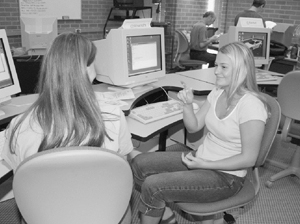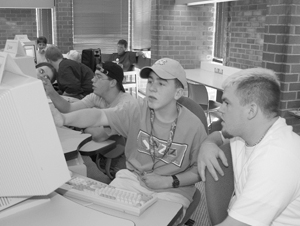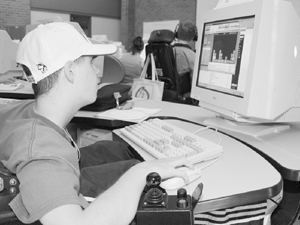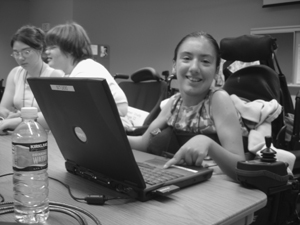Chapter One
An Introduction to E-mentoring and E-communities
No country, however rich, can afford the waste of its human resources.
— Franklin D. Roosevelt —
Individuals with disabilities experience far less career success than their peers who do not have disabilities; however, differences in achievement diminish significantly for those who participate in postsecondary education (Blackorby & Wagner, 1996; Stodden & Dowrick, 2000; Yelin & Katz, 1994). College graduates with disabilities achieve success in employment close to that achieved by those without disabilities. Although the rate of participation in higher education is lower for people with disabilities than it is for people without disabilities, this difference is diminishing (Henderson, 2001; National Council on Disability, 2000).
A bachelor's degree or higher is a prerequisite for many challenging careers, including high-tech fields in science, engineering, business, and technology. Few students with disabilities pursue postsecondary academic studies in these areas, and the attrition rate of those who do is high (National Science Foundation, 2000; Stodden & Dowrick, 2000).
Lack of job skills and related experiences also limit career options for people with disabilities (Colley & Jamieson, 1998; Unger, Wehman, Yasuda, Campbell, & Green, 2001). They also have little contact with other people with disabilities and, thus, limited access to positive role models with disabilities (Seymour & Hunter, 1998).
Low expectations of and lack of encouragement from those with whom they interact can impede the realization of the full potential of people with disabilities in challenging fields. Support systems in high school are no longer available after graduation, and many students with disabilities lack the self-determination, academic, and independent living skills necessary to make successful transitions to college and careers (National Information Center for Children and Youth with Disabilities, 1999).
Youth with disabilities more often continue to live with their parents or in other dependent living situations after high school than their peers without disabilities. They also engage in fewer social activities. The effect of social isolation can be far-reaching, affecting not only personal well-being but also academic and career success (Seymour & Hunter, 1998).
The lives of some people with disabilities demonstrate that they can overcome challenges imposed by inaccessible facilities, curriculum materials, equipment, and electronic resources; lack of encouragement; and inadequate academic preparation and support (American Association for the Advancement of Science, 2001; National Center for Educational Statistics, 2000; National Council on Disability and Social Security Administration, 2000). Steps to careers for students with disabilities include preparing for, transitioning to, and completing a college education; participating in relevant work experiences; and transitioning from an academic program to a career position.
Research studies have identified successful practices for bringing students from underrepresented groups into challenging fields of study and employment. They include the provision of:
- technology
- programs that bridge between academic levels and between school and work
- work-based learning opportunities
- peer support
- mentoring
In this chapter, strategies developed in DO-IT's award-winning online mentoring community are shared so that you can apply successful practices in your program.
Acknowledgement: Much of the content of this chapter is published in earlier work (Burgstahler, 1997, 2003b, 2006a; Burgstahler & Cronheim, 1999, 2001; DO-IT, 2005).
Peer, Near-Peer, and Mentor Support
Most of us can think of people in our lives who supplied information, offered advice, presented a challenge, initiated a friendship, or simply expressed an interest in our development as a person. Without their intervention we might have remained unaware of a resource, neglected to consider an exciting opportunity, progressed toward a goal at a slower pace, or given up on a goal altogether.

Supportive relationships with peers and adults can positively impact the transition period following high school when a student's structured environment ends and precollege support systems are no longer in place. Within social support systems, participants provide what has been defined as communication support behavior, "whereby individuals within a formal social system offer and receive information and support from one another in a one-way or reciprocal manner" (Hill, Bahniuk, Dobos, & Rouner, 1989, p. 356).
Mentor Support
The term mentor comes from Homer's Odyssey, in which a man named Mentor was assigned the task of educating the son of Odysseus. Protégé (or mentee) refers to the person who is the focus of the mentor's efforts. Mentoring has long been associated with a variety of activities including counseling, role modeling, job shadowing, advice-giving, and networking.
Young people with disabilities can be positively influenced by observing role models with similar disabilities successfully pursuing education and careers that they might otherwise have thought impossible for themselves. Mentors can help their protégés explore career options, set academic and career goals, examine different lifestyles, develop social and professional contacts, identify resources, strengthen interpersonal skills, achieve higher levels of autonomy, and develop a sense of identity and competence. Information, guidance, motivation, resources, and emotional support provided by mentors can help young people successfully transition from high school into the less structured environments of postsecondary education, employment, and community living.
Protégés report benefits of mentoring to include
- better attitudes toward school and the future,
- decreased likelihood of initiating drug or alcohol use,
- greater feelings of academic competence,
- improved academic performance, and
- more positive relationships with friends and family (Campbell-Whatley, 2001).
Protégés are not the only ones who benefit from mentoring relationships. Adults can also find satisfaction in their helping roles. Common positive effects for mentors include
- increased self-esteem,
- feeling of accomplishment,
- insights into childhood and adolescence, and
- personal gain, such as increased patience, a sense of effectiveness, and the acquisition of new skills or knowledge (Rhodes, Grossman, and Resch, 2000).
In summary, "mentoring is a win-win situation. Young people win, adult volunteers win. It is, quite frankly, society at large that is eventually the real winner" (Saito & Blyth, 1992, p. 60).
Group Mentoring
At least in part because of a shortage of available adult mentors, group mentoring programs have emerged. Typically, in this model one mentor is assigned to a small group of young people. In group mentoring, mentors cannot provide as much individual attention to each young person as they might in the traditional one-to-one model, but positive outcomes can also be achieved as a result of participant interactions. Although, as with one-to-one mentoring, most group mentors want to develop personal relationships with protégés, they also promote positive peer interactions. Participants report that group mentoring helps them improve social skills, relationships with individuals outside of the group, and, to a lesser extent, academic performance and attitudes (Herrera, Vang, & Gale, 2002; Sipe & Roder, 1999).
Peer and Near-Peer Support
Peers can offer some of the same benefits to young people as mentors. Like mentors, peers can coach and counsel, offer information and advice, provide encouragement, act as sounding boards, function as positive role models, and promote a sense of belonging. Peers of the same age offer unique opportunities for sharing, are easier for participants to approach than adult mentors, and typically develop relationships that are longer lasting than those established with adults. While mentoring relationships are primarily one-way helping relationships, peer relationships offer a higher degree of mutual assistance, with both individuals giving and receiving support. Peers facing similar challenges related to their disabilities can share strategies to overcome disability-related barriers.
Relationships with individuals who are a year or two older than protégés, sometimes called near-peers, offer a powerful combination of the benefits of peer and mentor relationships. Near-peers and protégés can discuss issues such as whom on campus to tell about a disability, how to communicate with professors about accommodations, how to live independently, and how to make friends. In addition, near-peers can become empowered as they come to see themselves as contributors and role models.
Computer-Mediated Communication
Mentor, peer, and near-peer relationships have the potential to provide students with disabilities with psychosocial, academic, and career support, thereby lessening or eliminating some of the unique challenges they face. However, these types of relationships can be limited by physical distance, time, and schedule constraints and, in some cases, disability-related communication barriers (e.g., speech impairments, deafness).

For these relationships to be successful, it is often necessary to match young people and mentors who are in close geographic locations. Even if such relationships can be established, communication, transportation, and scheduling problems must be resolved. In short, arranging traditional in-person mentoring and peer support for this population is problematic.
Computer-mediated communication (CMC), wherein people use computers and networks to communicate with one another, makes communication across great distances and different time zones convenient, eliminating the time and geographic constraints of in-person communication. CMC facilitates the development of communities for people with common interests, regardless of their physical locations. Using electronic mail, text messaging, chat rooms, web-based forums, and other technology to sustain meaningful relationships between people who are geographically disconnected allows us to reconsider the concept of community as a physical location. The lack of social cues and social distinctions like gender, age, disability, race, and physical appearance in CMC can make even shy participants willing to share their views.
The development of computers and assistive technology makes electronic communication possible for all individuals, regardless of disability. For example, a person who is blind or has a disability that makes reading difficult can use text-to-speech software to read aloud text presented on a computer screen. An individual with limited use of his hands can use a trackball, a headstick, speech input, or an alternative keyboard to control the computer; and a person with a speech or hearing impairment may be able to participate more fully in communications when they are conducted electronically.
E-Mentoring Communities
Online discussion groups, chat rooms, web-based forums, and other CMC vehicles have emerged as popular tools for interaction between individuals within groups. When CMC is the mode for communication between mentors and their protégés, it has been called e-mentoring, online mentoring, or telementoring. As in traditional on-site mentoring, the mentor, often an adult, develops a close relationship with a younger person in order to promote his or her well-being and success.
One advantage of an online mentoring community (or electronic mentoring community, or e-community), as compared to more traditional one-to-one electronic mentoring, is that mentors observe the communications of other mentors as well as the responses of all of the young people in the community. In this format, once basic guidelines are provided, mentors learn effective mentoring techniques on the job. They can also more effectively and efficiently share their expertise and insights, since no individual is responsible for providing all mentoring communications with a specific protégé in the community. With this approach, each participant benefits from the expertise of a group of mentors, peers, and near-peers.
DO-IT's E-Mentoring Community
In DO-IT programs, mentor, peer, and near-peer support sometimes occurs in person, but most of the time is delivered through its e-mentoring community. Participants are mentored within a group, and many contributors are included in interactions. Participants also disseminate academic and career-enhancing resources that benefit all community members. Positive aspects of DO-IT's e-community approach include the following:
- Individuals benefit from the experiences of a large group of mentors, peers, and near-peers.
- Mentors can specialize in the areas of their strongest expertise.
- The program performs successfully even though some mentors are less available and skilled than others.
- Using asynchronous, text-based communication on the Internet eliminates barriers faced by other forms of communication that are imposed by location, schedule, and disability.
- The program administrator views all group communications that take place, thus finding it easy to guide and contribute to conversations.
- Mentors learn techniques from each other by attending to the communications that take place.

Most DO-IT Mentors are college students, faculty, engineers, scientists, or other professionals who have disabilities. Protégés are participants in the DO-IT Scholars and DO-IT Pals programs (DO-IT, 2006a,c; Burgstahler, 2007). These students are making plans for postsecondary education and careers. They all have disabilities, including vision, hearing, mobility, and health impairments and specific learning disabilities. Frequent electronic communications and personal contacts bring DO-IT protégés, near-peers, and mentors together to facilitate academic, career, and personal achievements.
Introducing protégés to DO-IT Mentors with similar disabilities is a strength of DO-IT's program. One protégé reported she had never met an adult with a hearing impairment like hers before getting involved in DO-IT: "But when I met him, I was so surprised how he had such a normal life, and he had a family, and he worked with people who had normal hearing. So he made me feel a lot better about my future."
DO-IT's E-Mentoring Participants
DO-IT Scholars
High school students with disabilities who are accepted into the DO-IT Scholars program communicate electronically with Mentors and other DO-IT participants using computers and, if necessary, assistive technology. DO-IT Scholars who do not have the necessary technology are loaned equipment and software. DO-IT Scholars attend summer programs at the University of Washington in Seattle where they participate in academic lectures and labs, live in residence halls, and practice skills that will help them succeed in college and career settings.
DO-IT Ambassadors
When DO-IT Scholars graduate from high school and move on to postsecondary studies, they can become DO-IT Ambassadors, sharing their experiences and advice with DO-IT Scholars and DO-IT Pals and otherwise promoting DO-IT goals.
DO-IT Pals
Teens with disabilities who want to go to college and who have access to the Internet can apply to become DO-IT Pals. DO-IT Pals come from all over the world and use the Internet to explore academic and career interests and communicate with DO-IT Scholars, Ambassadors, and Mentors. To become a DO-IT Pal, a teenager with a disability who already has access to the Internet must send email to doit@u.washington.edu.
DO-IT Mentors
Adult Mentors are an important part of the DO-IT team. DO-IT Mentors are college students, faculty, and professionals in a wide variety of career fields. Many DO-IT Mentors have disabilities themselves. Mentors support DO-IT Scholars, Ambassadors, and Pals as they transition to college, careers, and self-determined lives.
DO-IT Staff
The e-mentoring community administrator monitors discussions, introduces new members to the group, and sends messages with mentoring tips to the mentors and lessons and activities to all members of the community. Other staff join in discussions, particularly during times of low participation by others, and send useful information and resources.
DO-IT e-community participants learn strategies for success in academics and employment. Mentors provide direction and motivation, instill values, promote professionalism, and help protégés develop leadership skills. As one DO-IT Scholar noted, "It feels so nice to know that there are adults with disabilities or who know a lot about disabilities, because I think that people who are about to go to college or start their adult life can learn a lot from mentors . . ." As DO-IT Scholars move from high school to college and careers, they too, as DO-IT Ambassadors, become mentors and role models, sharing their experiences with younger participants.
There are probably as many mentoring styles as there are personality types, and no one can be everything to one person. Each DO-IT participant benefits from contact with many mentors, peers, and near-peers. One-to-one relationships develop naturally as common interests are identified by pairs of mentors, protégés, peers, and near-peers. DO-IT also facilitates communication in small groups through the use of electronic discussion lists. For example, one group includes Mentors, protégés, and near-peers who are blind. Participants in this group discuss common interests and concerns such as independent living, speech and Braille output systems, and options for displaying images and mathematical expressions.
While most communication occurs electronically, some Mentors and near-peers meet DO-IT Scholars during DO-IT Summer Study programs on the University of Washington Seattle campus and at other DO-IT activities across the United States. In-person contact strengthens relationships formed online.
DO-IT has been studying the nature and value of electronic mentoring since 1993. Thousands of electronic mail messages were collected, coded, and analyzed; surveys were distributed to DO-IT Scholars and Mentors, and focus groups were conducted (Burgstahler & Cronheim, 2001).
Findings suggest that computer-mediated communication can be used to initiate and sustain peer-peer and mentor-protégé relationships and alleviate barriers to traditional communications due to time and schedule limitations, physical distances, and disabilities of participants. Both young people and mentors actively communicate on the Inter-net and report positive experiences in using the Internet as a communication tool.
The Internet gives these young people support from peers and adults otherwise difficult to reach, connects them to a rich collection of resources, and provides opportunities to learn and contribute. Participants note benefits over other types of communication. They include the ability to communicate over great distances quickly, easily, conveniently, and inexpensively; the elimination of the barriers of distance and schedule; the ability to communicate with more than one person at one time; and the opportunity to meet people from all over the world. Many report the added value that people treat them equally because they are not immediately aware of their disabilities. Negative aspects of electronic communication include difficulties in clearly expressing ideas and feelings, high volumes of messages, and occasional technical difficulties.

DO-IT's online program has received national recognition with its 1997 Presidential Award for Excellence in Mentoring "for embodying excellence in mentoring underrepresented students and encouraging their significant achievement in science, mathematics, and engineering." It also received the National Information Infrastructure Award in 1995 "for those whose achievements demonstrate what is possible when the powerful forces of human creativity and technologies are combined." Research results suggest the success of the DO-IT electronic community in promoting positive college and career outcomes (e.g., Burgstahler, 1997, 2001, 2002b, 2003a; Burgstahler & Cronheim, 2001; Kim-Rupnow & Burgstahler, 2004). But more importantly, the DO-IT electronic mentoring community has documented its value in the successful lives of its participants and the willingness of those who were once protégés to support young people in the community as they were supported in their youth.
The findings of research on DO-IT's e-mentoring community suggest that peer-peer and mentor-protégé relationships on the Internet perform similar functions in providing participants with psychosocial, academic, and career support. However, each type of relationship has its unique strengths. For example, peer-peer communication includes more personal information than exchanges between mentors and protégés.
Building on the successes of DO-IT and other online mentoring programs, practitioners should consider using the Internet as a vehicle for developing and supporting positive peer and mentor relationships.
Contributions of DO-IT Participants
Everyone in the DO-IT electronic mentoring community benefits from participation. DO-IT Mentors and near-peers in their mentoring role offer protégés
- Information—Mentors share their knowledge and experiences.
- Contacts—Mentors introduce their protégés to valuable academic, career, and personal contacts.
- Challenges—Mentors stimulate curiosity and build confidence by offering new ideas, strategies, and opportunities.
- Support—Mentors encourage growth and achievement by providing an open and supportive environment.
- Direction—Mentors help protégés discover their talents and interests and devise strategies to attain their goals.
- Advice—Mentors make suggestions to help protégés reach academic, career, and personal goals.
- Role Modeling—Mentors let protégés know who they are and how they have reached their goals.
DO-IT protégés offer Mentors
- Challenge—Mentors develop their own personal styles for sharing their skills and knowledge via electronic communication.
- Opportunities to Help Set Goals—Mentors encourage DO-IT participants to listen to their hearts and think about what they really want to do.
- A Chance to Share Strategies—Mentors pass on hard-earned experiences.
- New Ideas—Mentors join an active community of talented students and professionals with a wide range of disabilities who are eager to share their own strategies for problem solving and success.
- Fun—Mentors share in the lives of motivated young people, listening to them, hearing about their dreams, helping them along the road to success—it's fun!
Joining an Existing Online Mentoring Program
As is apparent by the size of this book, it takes a great deal of time and effort to develop and support your own electronic mentoring community. Steps involved are outlined in the following chapter. If you do not have the resources to make this commitment, consider finding an existing community to join. For example, DO-IT hosts an electronic community for teens with disabilities, near-peers, and mentors. DO-IT Scholars, Ambassadors, and Mentors are members. In addition, any teen with a disability who plans to go to college can apply to join the community as a DO-IT Pal. DO-IT Pals receive peer, near-peer, and mentor support, as well as access to a rich collection of resources. Teens with disabilities can simply send an email message to doit@u.washington.edu to join DO-IT Pals. More information about this program can be found in the video DO-IT Pals: An Internet Community, and the accompanying brochure, DO-IT Pals. They can be found on the DO-IT Pals page or purchased from DO-IT.
Other online mentoring options for students with disabilities can be found in the DO-IT Knowledge Base article Are there electronic mentoring programs for students with disabilities?
Just DO-IT!
Whether you mentor a young person, connect one child with a caring adult, create a small mentoring group in your church or school, develop an elaborate electronic mentoring community, or encourage young people to join an existing online mentoring program, find ways to make mentoring a part of the lives of the young people with whom you interact.
The next chapter tells you how to create an electronic mentoring community. The chapters that follow provide mentoring tips and activities that can be adapted for any mentoring environment.